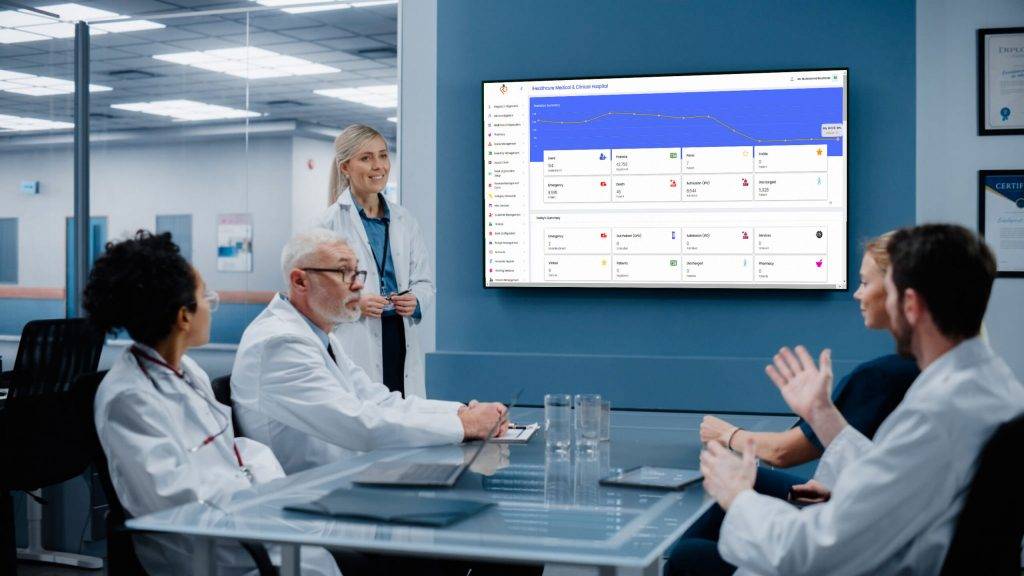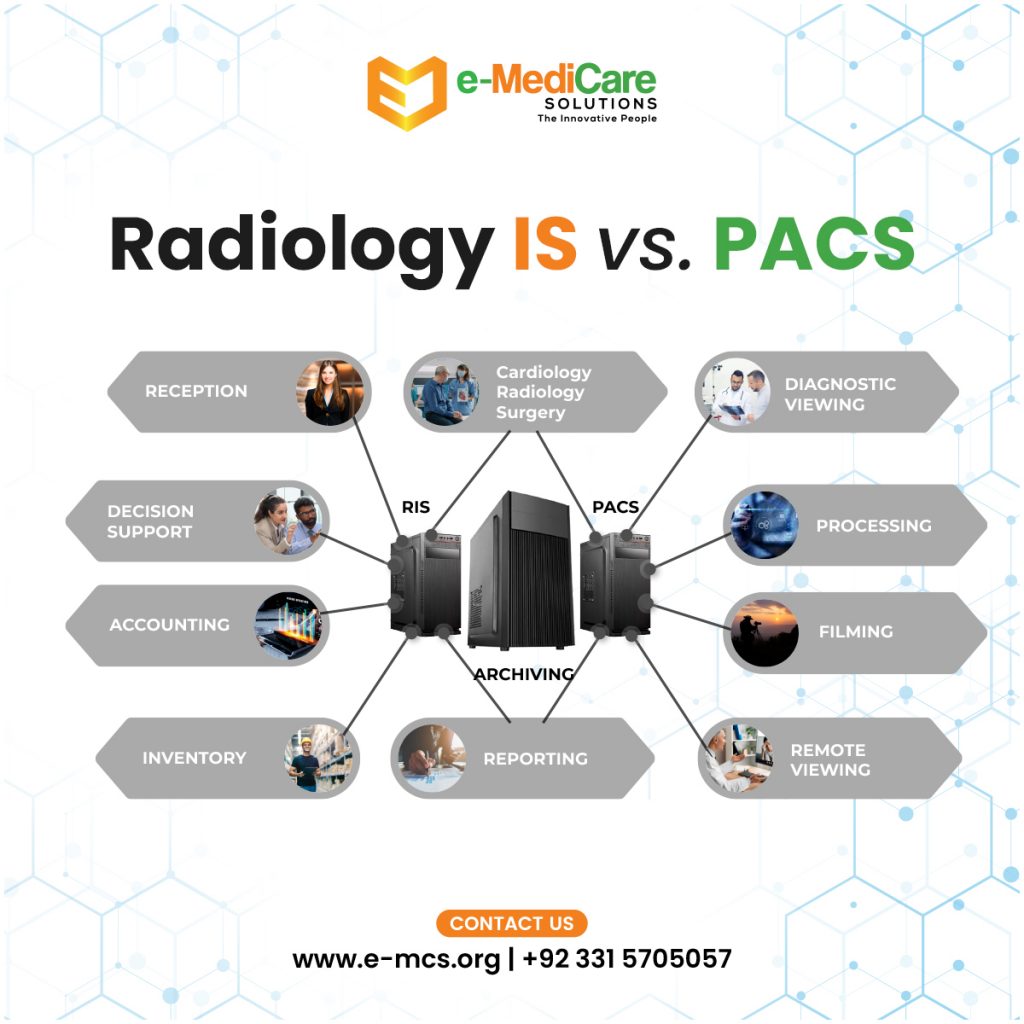RIS/PACS integration
PowerServer™ RIS/PACS
PowerServer™ PACS
PowerServer™ Cloud
RIS/PACS Integration FAQs
What is the difference between a RIS and a PACS?
What is the difference between a RIS and an EMR?
What is the difference between a PACS and an EMR?
What is the difference between a VNA and a PACS?
What is the difference between a VNA and a RIS?
What is the difference between a VNA and an EMR?
Conclusion
Benefits of RIS/PACS Integration
Learn about the benefits of RIS/PACS integration, including improved workflow efficiency, better patient care, and streamlined access to medical imaging data.
RIS manages patient data and radiology workflow, while PACS is for storing, retrieving, and distributing medical images. RIS/PACS integration streamlines these processes.
radiology information system/PACS integration solutions like RamSoft’s PowerServer™ RIS/PACS offer cloud-based options for seamless integration and efficient healthcare technology management.
Real-Life Case Study: The Impact of RIS/PACS Integration
I had the opportunity to witness first-hand the transformative impact of RIS/PACS integration. Before the integration, our workflow was cumbersome and time-consuming. We had to manually enter patient data into the RIS and then separately access the PACS to view images, often leading to delays in patient care.
After integrating RamSoft’s PowerServer™ radiology information system/PACS solution, our department experienced a significant improvement in efficiency. The seamless integration allowed us to access patient data and imaging studies from a single platform, streamlining our workflow and reducing the risk of errors. This not only saved time but also greatly enhanced the quality of patient care.
One particular case stands out in my mind. A critical patient needed urgent imaging, and thanks to the integrated radiology information system/PACS, we were able to swiftly access the necessary information and images, leading to a prompt diagnosis and timely intervention that ultimately saved the patient’s life. The ability to access and share real-time data between the radiology information system and PACS was truly a game-changer for our department and the patients we serve.
In the dynamic world of healthcare technology, the integration of a Radiology Information System (RIS) and Picture Archiving and Communication System (PACS) stands as a pivotal advancement, revolutionizing how radiology departments manage and disseminate imaging data. radiology information system/PACS integration is designed to streamline the workflow within radiology practices, offering a unified platform for patient management, imaging processing, and storage. This synergy not only enhances the efficiency of healthcare providers but also improves patient outcomes by ensuring that critical imaging data is readily accessible when needed.
RIS/PACS Integration
What is radiology information system/PACS Integration?
RIS/PACS integration refers to the seamless connection between RIS software, which manages patient scheduling, reporting, and billing, and PACS, a system that stores, retrieves, presents, and shares images from various medical imaging instruments. This integration allows for a more cohesive workflow, enabling radiologists and other healthcare professionals to access patient images and data through a single interface.
Benefits of RIS/PACS Integration
The benefits of integrating radiology information system with PACS are multifold:
Improved Workflow Efficiency: By eliminating the need to switch between separate systems for different tasks, clinicians can save time and reduce the risk of errors.
Enhanced Patient Care: Integrated systems provide quicker access to patient records and images, leading to faster diagnosis and treatment.
Cost Reduction: Streamlining operations can result in cost savings by reducing the need for duplicate tests and minimizing administrative overhead.
Data Security and Compliance: A unified system is often easier to secure and can be updated to comply with evolving healthcare regulations.
Scalability: As the practice grows, an integrated system can more easily adapt to increased data volumes and additional functionalities.
How to Choose the Right RIS/PACS Integration Solution
Selecting the correct radiology information system/PACS integration solution necessitates a careful analysis of the following:
Compatibility: Ensure the solution is compatible with existing systems and modalities within your healthcare facility.
Functionality: Evaluate the features and whether they align with your organization’s specific needs.
User Experience: The system should have an intuitive interface that simplifies tasks for users.
Vendor Support: Look for vendors that offer robust support and training options.
Future-proofing: Consider whether the solution can accommodate future technology advancements and regulatory changes.
Image representing a checklist for choosing RIS/PACS Integration Solution
RIS/PACS Integration with RamSoft
PowerServer™ RIS/PACS
The PowerServer™ RIS/PACS is a comprehensive solution by RamSoft that combines the capabilities of both radiology information system and PACS into a single, powerful platform. It is designed to optimize radiology workflows, enhance patient care, and improve productivity.
Image of PowerServer™ RIS/PACS Interface
PowerServer™ PACS
For facilities that require a standalone PACS with the option to integrate with an existing RIS, RamSoft’s PowerServer™ PACS offers a robust, scalable solution capable of handling large image datasets and a variety of imaging modalities.
Image of PowerServer™ PACS Interface
PowerServer™ Cloud
RamSoft’s PowerServer™ Cloud takes integration a step further by offering a cloud-based RIS/PACS solution. This allows for unparalleled access to patient data and images from any location, enhancing collaboration among healthcare professionals and supporting telemedicine initiatives.
Image of PowerServer™ Cloud Platform
RIS/PACS Integration FAQs
What is the difference between a RIS and a PACS?
A RIS primarily manages patient information, scheduling, and billing, while a PACS focuses on the storage and retrieval of medical imaging.
What is the difference between a RIS and an EMR?
An EMR (Electronic Medical Record) is a broader system that contains the patient’s medical history, of which RIS is a component that caters specifically to radiology.
What is the difference between a PACS and an EMR?
While PACS is dedicated to imaging management, an EMR encompasses a wider range of medical data, including lab results, physician notes, and treatment history.
What is the difference between a VNA and a PACS?
A VNA (Vendor Neutral Archive) is designed to store images in a standard format from various vendors, whereas PACS often uses proprietary formats and may not support images from different sources without integration.
What is the difference between a VNA and a RIS?
VNA is an image-centric platform, what is RIS is focused on the operational and administrative side of radiology.
What is the difference between a VNA and an EMR?
A VNA is specialized for long-term image storage across multiple departments, while an EMR is a comprehensive record of a patient’s medical history, inclusive of diagnostic reports, treatment plans, and more.
Conclusion
In conclusion, radiology information system/PACS integration is a transformative approach in healthcare technology that effectively bridges the gap between patient information management and medical imaging. As healthcare settings strive for more efficient, accurate, and patient-focused care, the integration of these systems becomes increasingly crucial. By understanding the benefits, knowing how to choose the right solution, and exploring offerings like RamSoft’s PowerServer™ products, facilities can significantly enhance their radiology services. Now is the time for healthcare providers to embrace this integration for a more streamlined, secure, and patient-centered future in medical imaging.
Want to learn more about RIS/PACS integration and how it can benefit your practice? Visit emedicare solutions for expert advice and industry-leading technology. Follow us For More latest technology Updates or Facebook.
















